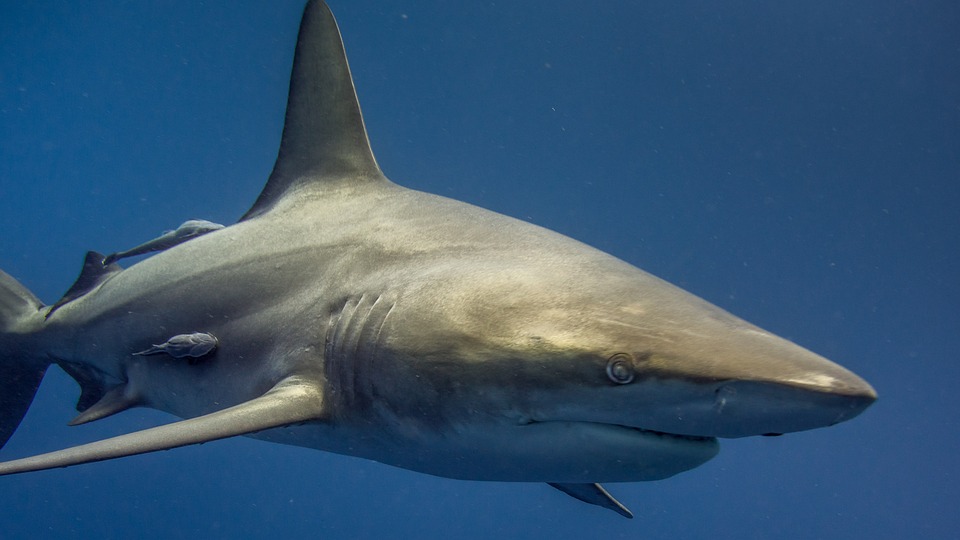No matter how you feel about sharks, we can probably agree they’re one of the most mysterious creatures in the deep blue sea. Stealthy and effortless, they cruise through the waters with precision and speed.
We’d like to give you facts about sharks that might help you change your mind about them. Good or bad, they’re magnificent beings that benefit mankind. Apex fish, or predators at the top of the food chain, sharks are indicators of ocean health. They also help maintain lesser species diversity, proving their importance for the ecosystem.
Some think sharks are mammals, but they’re simply…fish. Not simply, they have a mesmerizing effect when seen in the wild or in captivity.
The problem is…all those teeth, and probably the dark eyes, too, may be what strikes fear in so many people. No, they don’t look like furry puppies but still deserve the appreciation any living, breathing thing on our planet does.
Let’s talk about spiracles and cartilage and teeth, oh my! We’re big fans and hope you will be, too, as we dive into facts about sharks.
10 Most Mesmerizing Facts About Sharks
- Sharks appeared in the ocean about 450 million years ago
- The largest recorded shark was a whale shark measuring 41.5 feet
- The dwarf lantern shark measures just six inches, making it the smallest shark
- Sharks have exceptionally good eyesight
- Researchers determine the age of sharks by counting the rings on their vertebrae
- Numerous deep-sea sharks create their own illumination through bioluminescence
- Sharks are among 5% of species that survived 5 major mass extinctions
- Whale sharks have the potential to live up to 100 years
- Certain female sharks can retain stored sperm for as long as a year
- Quite a number of shark species are in the IUCN list of vulnerable to critically endangered
Facts About Sharks
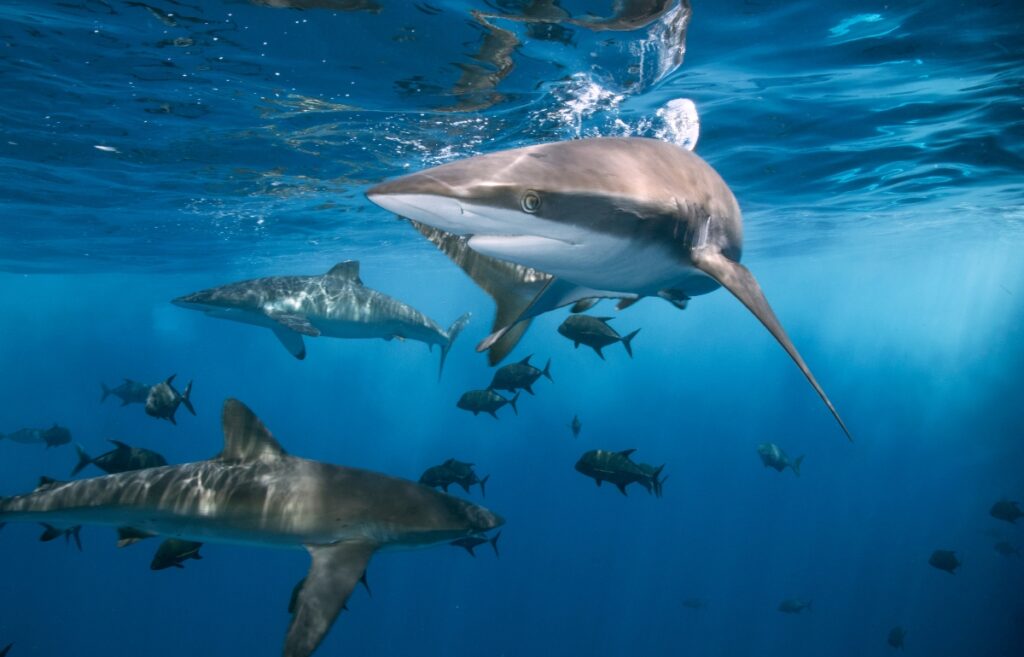
Get ready to learn which shark is the fastest, the smallest, and the one who doesn’t need a man to have a baby. We can’t promise to take all your fears away, but we can guarantee you’ll learn something you didn’t know about these monumental fish.
Sharks Appeared in the Ocean About 450 Million Years Ago. (Natural History Museum)
This was during the Ordovician Period. A time when marine fauna increased fourfold. Ocean life was full of sea moss animals, snails, and a sudden plethora of trace fossils. It was also when coral reefs first became known. (source)
There Are More Than 500 Species of Shark. (IFAW.org)
They can be divided into eight orders or groups. Within each order, the physical characteristics, behavior, and biology are explained. All are cartilaginous fish, which means their skeletons are made of cartilage rather than bone. (source)
The Largest Recorded Shark Was a Whale Shark Measuring 41.5 Feet. (Animals Around the Globe)
In 1947, this massive specimen was caught off the coast of Pakistan. I was incredulous about the story, but after thorough research, I found CBS News video proof. It was reported the shark had washed up on shore.
At an enormous 21.5 tons, it’s now displayed at the Marine Fisheries Department in Karachi, Pakistan. (source)
The Dwarf Lantern Shark Measures Just Six Inches, Making It the Smallest Shark. (Smithsonian Ocean)
Elusive, rarely observed, and adorable in its own way, it has been seen in South America at depths between 928 to 1,440 feet. This tiny shark’s belly and fins light up via organs called “photophores.” It camouflages the fish in shallow water to mimic the sunlight.
Most Sharks Are Cold-Blooded. (Florida Museum)
Sharks, like fish, are mostly cold-blooded or ectothermic. Their body temperatures match the temps of their environment. But five shark species are warm-blooded or endothermic: Mackerel (includes the white shark), shortfin mako, longfin mako, porbeagle, and salmon.
Sharks Have Exceptionally Good Eyesight. (International Wildlife Museum)
A major myth about sharks is that they don’t see well; however, they can actually see in color and in low light. They notice their prey from a distance of 70-100 feet away. Compared to a human’s eyesight, theirs is ten times more sensitive to light.
Special Electroreceptor Organs are Present in Sharks. (Science Direct)
All beings produce electric fields which we give off through our heartbeat and muscle movement. Sharks have special receptors that can detect electromagnetic fields. These electroreceptors can not only find a prey fish’s heartbeat that is hidden under the sand but can also detect changes in the electrical field of the earth. (source)
When a Shark Is Inverted, It Enters a Trance-Like State Known as Tonic Immobility. (American Oceans)
Similar to an opossum or even some snakes and rabbits that “play dead” if a predator is sensed, sharks do something similar. But it’s not only a defensive strategy. Tonic immobility can also be triggered by water temperature, salinity, and shark repellents.
Researchers Determine the Age of Sharks by Counting the Rings on Their Vertebrae. (NOAA.gov)
Pairs of bands are located on the vertebrae. Like rings on a tree, they’re counted, but that’s not the end of it. Researchers must study each species and size class since the deposition rate may change over time.
But here’s the kicker – It’s not an exact science, especially studying the age of sharks over the age of 50. According to National Geographic, there is a newer, better way of estimating a shark’s age, and it’s called “bomb radiocarbon dating.”
Certain Sharks Have a Spiracle That Lets Them Breathe at Rest, While Others Need to Swim to Pass Water Over Their Gills. (Save Our Seas Foundation)
It’s a myth that all shark species need to swim to stay alive. Nurse and bullhead sharks both use ram ventilation to breathe while staying in place. It’s called “buccal pumping,” which gives them the ability to still pump water over their gills/spiracles even while staying still.
How Many Bones Do Sharks Have
Ever wondered about the bone structure of sharks? Let’s learn more about these incredibly weird animals and see how their bodies differ from others:
Sharks Don’t Have Any Bones In Their Body. (NOAA Fisheries.gov)
We talked about how they have cartilage – the stuff our ears and nose tips are made of – instead of bones, which makes them elasmobranchs. Cartilage is lighter than bone and helps their buoyancy.
Fun Facts About Sharks
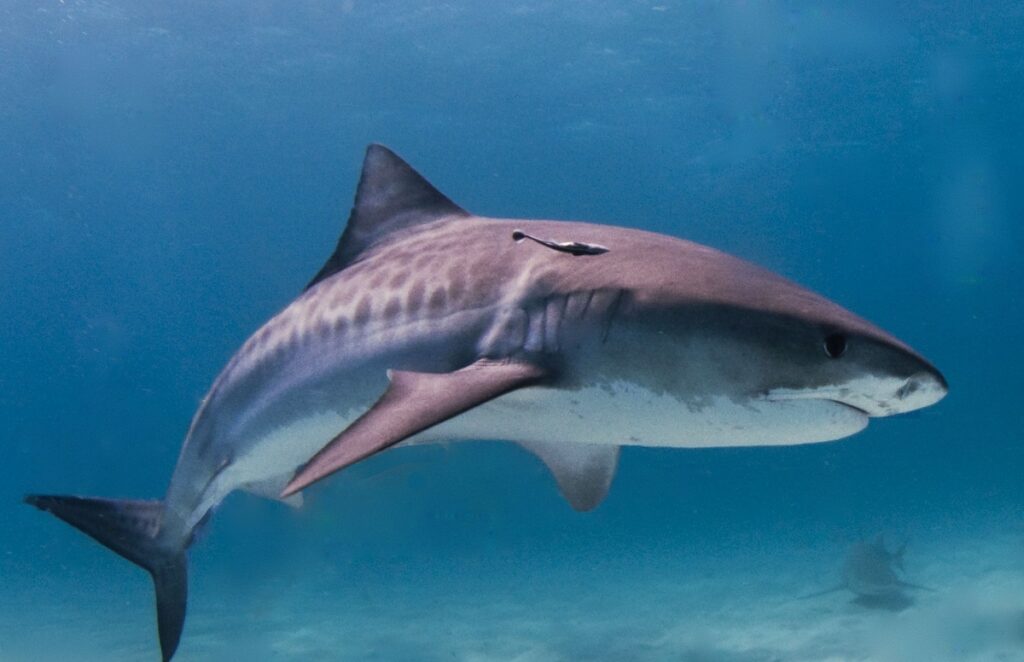
Let’s dive into the fascinating underwater realm and uncover intriguing and jaw-dropping facts about the ocean’s apex predators:
Sharks Exhibit Significant Variation in Size. (Smithsonian Ocean)
Sharks come in all shapes and sizes and range from 6 inches to 41 feet long. You’ve learned about the dwarf lantern shark – 6” – and the whale shark can reach up to 41’. The basking sharks are known as gentle giants of the sea, for their massive size and filter-feeding lifestyle.
Sharks Can Be Both Fascinating and Bizarre. (Johns Hopkins University)
- Some shark species can travel (migrate) thousands of miles per year, like whale sharks, to feed and mate. A 12,000-mile one-way trip was recorded from near Panama to the Philippines by a whale shark given the name Anne.
- Although most sharks live in saltwater, the bull shark can survive in freshwater due to certain adaptations and has been found in rivers. (And if you weren’t already scared of sharks…!)
Numerous Deep-Sea Sharks Create Their Own Illumination Through Bioluminescence. (National Geographic)
Twelve percent of sharks in the ocean glow. No larger than a foot and a half long, they live in the deep sea. As such, studies are ongoing to learn more about them. They do know the three different shark species include kitefin sharks and lantern sharks.
The Texture of Shark Skin Resembles That of Sandpaper. (Florida Museum)
When you look at a shark, it can seem like it would be smooth like plastic, but its skin feels like sandpaper. It’s made of placoid scales, also called dermal denticles, and are pointed and grooved and positioned to point towards the tail. Denticles don’t grow larger as the shark grows; instead, the fish grows more of them.
Female Sharks Have Thick Skin. (NIH)
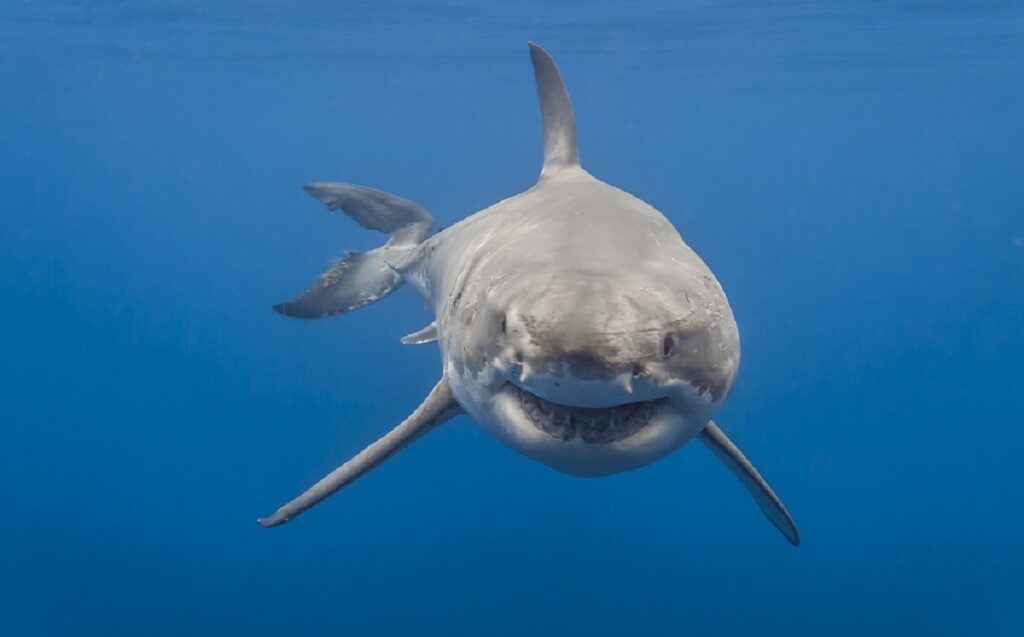
They also have greater denticle density and overlap. (Denticles are flat, V-shaped scales that are teeth-like.)
Shark skin is a composite of mineralized dermal denticles embedded in an internal collagen fiber network and is sexually dimorphic. (source)
Surprisingly, Sharks Are Older Than Dinosaurs. (Natural History Museum)
It’s easy to think dinosaurs were around before just about any living creature, but that wouldn’t be true. The Mesozoic Era, 66 million–245 million years ago, was the period of the (non-bird) dinosaurs. Sharks made their entrance around 450 million years ago.
Sharks Are Among 5% of Species That Survived 5 Major Mass Extinctions. (Natural History Museum)
It’s well-known that dinosaurs went extinct from what is thought to have been a catastrophic asteroid. That event alone led to the extinction of 55-76% of the world’s species, but the shark extinction was only around 59%. There have been four other mass extinction events, and sharks survived all of them.
The Average Lifespan of Sharks Is 20 to 30 Years in the Wild. (IFAW.org)
Some sharks have lived 100+ years, and some have even lived 200+ years. Greenland sharks hold the record for being the longest-lived vertebrates, with some individuals reaching an astonishing age of at least 272 years. But sharks in captivity live much shorter lives due to their environment, read, insanely close quarters. At a minimum, sharks live eight years less than they do in the wild.
And consider this:
A shark arriving in a new captive environment and dying within a matter of months– if not days– is a very common occurrence. (source)
It’s common knowledge among animal advocates that aquariums aren’t quick to release records to the public of how long animals/fish live under their “care.” No exact number of years sharks lose from their lives can be reported.
Whale Sharks Have the Potential to Live Up to 100 Years. (Earth Island Institute)
Whale sharks, surviving solely on plankton and small fish, are believed to have a potential lifespan of up to 100 years. This is an estimation since each shark seems to have different lifespans. What may be truly surprising is that they only exist on plankton as they live such long lives.
Interesting Facts About Sharks
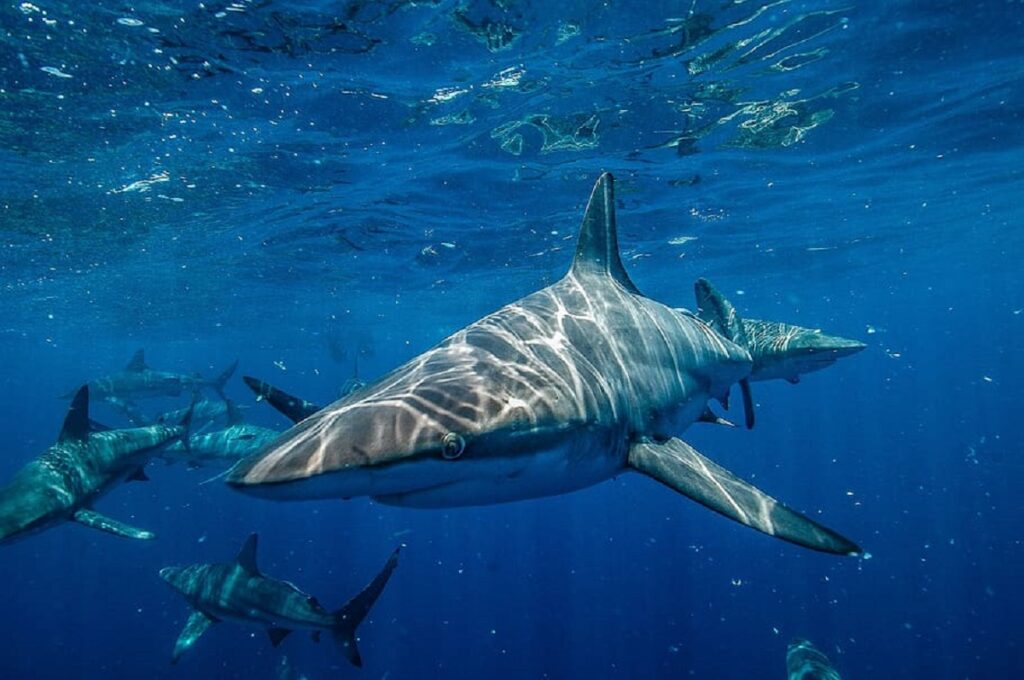
Let’s explore the intriguing facts and mysteries of these ancient creatures.
The Spot Pattern on Every Whale Shark Is Specific, Much Like a Fingerprint. (National Geographic)
As each person is unique, so is a whale shark’s spot pattern. Researchers can spot and track their migration more easily due to the unique formations on their bodies – Spots and stripes. (source)
Shark Teeth Vary Among Different Species. (American Oceans)
Similar to how alligators and crocodiles have different features, sharks can have teeth that are:
- Smooth
- Serrated
- Pointed
- Rounded
Depending on the variation, teeth can show what a shark’s feeding habits are.
Diverse Shark Species Have Varying Methods of Reproduction. (The Shark Trust)
There are four main forms of shark reproduction:
- Viviparity – This is a live birth, as in hammerhead shark etc.
- Oviparity – Mothers lay eggs.
- Ovoviviparity – Eggs hatch inside the mother.
- Parthenogenesis/Asexual – This rare form of reproduction occurs with no male fertilizing the eggs.
Most shark species practice ovoviviparity. (source)
Sharks, Being Predators, Help Maintain Balance in Marine Ecosystems. (One Earth.org)
In the natural order of things, sharks do what they do to keep the ocean working the way it should. Sharks play a vital role as they eat other predators, which prevents those fish from eating the herbivores that keep microalgae at bay – Microalgae eventually kill the coral reef system. (source)
Interestingly, Sharks Have a ‘Sixth Sense.’ (Sharks4kids)
Sharks have five senses, as we do. Their ‘sixth sense,’ electroreception, as we mentioned earlier, is located in their snouts and even has a name – Ampullae of Lorenzini. It is named after the Italian physician Stefano Lorenzini, who described it in 1678. (source)
Certain Female Sharks Can Retain Stored Sperm for as Long as a Year. (Science Daily)
Biologists at Steinhart Aquarium at the California Academy of Sciences were surprised when a shark got pregnant. Why? The bamboo shark hadn’t been exposed to a male in almost four years. This was the longest documented case of sperm storage.
Out of 500 Shark Species, Only About 30 Have Been Reported in Incidents Involving Humans. (Florida Museum)
One of the biggest misconceptions about sharks is that all sharks attack humans, which isn’t true. In actuality other dangerous animals, like moray eels, barracuda, bluefish, and stingrays are more of a threat.
Annually, 100 Million Sharks Get Killed Due to Commercial Fishing. (Greenpeace.org)
This statistic is difficult to swallow, but commercial fishing is taking out sharks by the millions. The world number of sharks and rays have been decreased by 71% since 1970. (source)
Since 1970, the Shark Population in the Ocean Has Declined by 70%. (Smithsonian Magazine)
Commercial fishing/Overfishing is the main cause of this incredible decrease. Ocean pollution is killing them, too. Setting boundaries, catch limits, and stricter regulations are critical to stop this gluttonous overreach.
Quite a Number of Shark Species Are on the IUCN List of Vulnerable to Critically Endangered. (IUCN Red List)
The IUCN’s Shark Specialist Group (SSG) is now recognized as the leading authority on the status of these species.
An estimated 37% of sharks, rays, and chimeras are threatened with extinction, according to the IUCN Red List of Threatened Species. – (source)
Shark Characteristics
- Dull gray, tough skin
- Toothlike scales.
- Muscular, asymmetrical, upturned tail
- Pointed fins
- Pointed snout
- Sharp triangular teeth.
Facts About Sharks for Kids
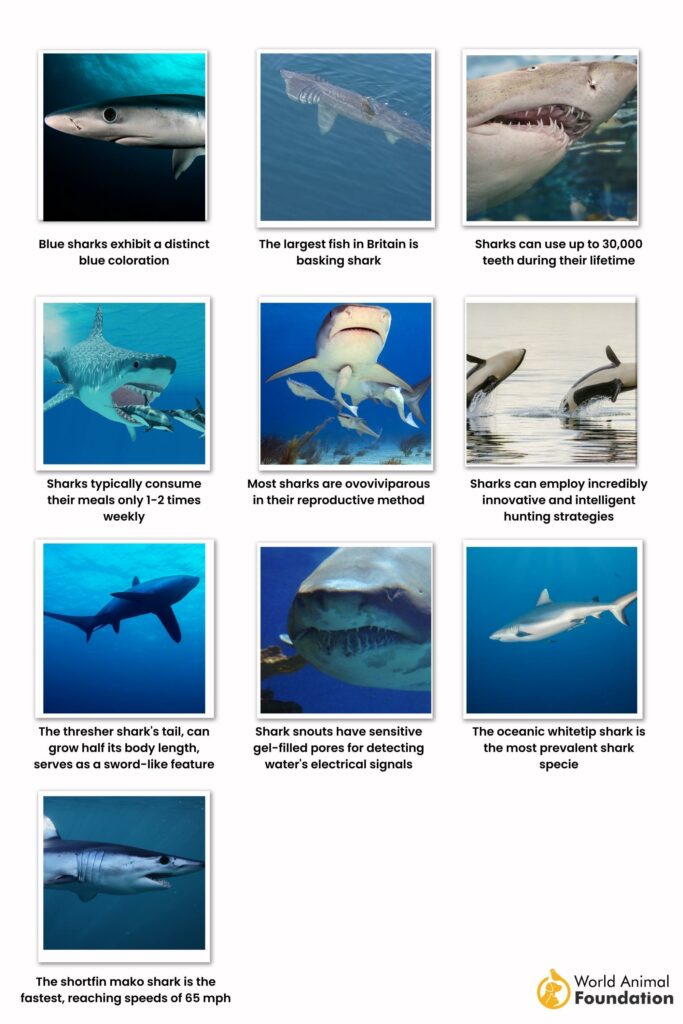
Sharks are truly amazing fish, and here are a few reasons why.
- Blue sharks are well-named since their bodies are a shade of blue.
- The most common shark species is the oceanic whitetip.
- What is the fastest shark? The shortfin mako.
- The largest fish in Britain is the basking shark.
- Sharks can use up to 30,000 teeth during their lifetime.
- Sharks eat their meals only once or twice weekly.
- The tail of thresher sharks can grow half its body length.
- Five of the top places to swim with sharks are South Africa, Mexico, Australia, Fiji, and Hawaii.
- Although most sharks are cold-blooded, five species are partially warm-blooded.
- Whale sharks are the biggest fish in the ocean.
- Great white sharks get their name from their white undersides.
FAQs
Do Sharks Have Bones?
No, sharks have cartilage, not bones.
Where Do Sharks Live?
Sharks can be found in tropical coral reefs, in the deep and the open ocean, under Arctic ice, and even in some rivers.
What Does a Shark Look Like?
There is no uniform way a shark looks; they’re incredibly diverse. Hammerhead sharks, orcas, angel sharks, tiger sharks, nurse sharks, bull sharks, and grey reef shark species all look completely different, as well as other shark species. You’d be mesmerized after looking at the prehistoric beauty of the Greenland shark.
How Many Sharks Are in the World?
It is estimated there may be 1 billion sharks in the world.
How Many Shark Species Are There?
There are more than 500 species of sharks.
Is a Shark an Animal?
Sharks are classified as fish rather than mammals/animals.
Scientific Name for Shark
Selachimorpha
How Old Are Sharks?
Sharks are 450 million years old.
Conclusion
Hopefully, your respect for sharks has grown. (Even if this article doesn’t have you rushing to a shark cage to hang out with them.) And before we exist in a world where they’re no longer with us, there are a few things you can do to help:
- Don’t eat fish of any kind.
- Never use products that contain Squalene.
- Sign a petition.
- Go plastic-free.
- Educate others about them.
Let’s take sharks off the red list. And let’s take personal responsibility and vow to do one or more of the suggestions above. They deserve our respect and admiration because sharks are not our predators. We are theirs!


